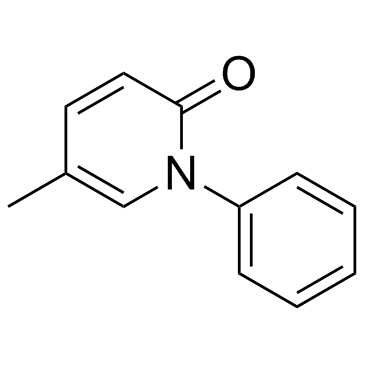
Pirfenidone
CAS No. 53179-13-8
Pirfenidone( AMR 69 )
Catalog No. M14890 CAS No. 53179-13-8
Pirfenidone is an inhibitor for TGF-β production and TGF-β stimulated collagen production.
Purity : >98% (HPLC)
 COA
COA
 Datasheet
Datasheet
 HNMR
HNMR
 HPLC
HPLC
 MSDS
MSDS
 Handing Instructions
Handing Instructions
| Size | Price / USD | Stock | Quantity |
| 50MG | 35 | In Stock |


|
| 100MG | 51 | In Stock |


|
| 200MG | 66 | In Stock |


|
| 500MG | 87 | In Stock |


|
| 1G | 132 | In Stock |


|
Biological Information
-
Product NamePirfenidone
-
NoteResearch use only, not for human use.
-
Brief DescriptionPirfenidone is an inhibitor for TGF-β production and TGF-β stimulated collagen production.
-
DescriptionPirfenidone is an inhibitor for TGF-β production and TGF-β stimulated collagen production, reduces production of TNF-α and IL-1β, and also has anti-fibrotic and anti-inflammatory properties. Phase 3.(In Vitro):Pirfenidone (PFD) reduces the protein levels of the matrix metalloproteinase (MMP)-11, a TGF-β target gene and furin substrate involved in carcinogenesis. These data define PFD or PFD-related agents as promising agents for human cancers associated with enhanced TGF-β activity. In RAW264.7 cells, a murine macrophage-like cell line, Pirfenidone suppresses the proinflammatory cytokine TNF-α by a translational mechanism, which is independent of activation of the MAPK2, p38 MAPK, and JNK. In the murine endotoxin shock model, Pirfenidone potently inhibits the production of the proinflammatory cytokines, TNF-α, interferon-γ, and interleukin-6, but enhances the production of the anti-inflammatory cytokine, interleukin-10. Pirfenidone (PFD) shows its inhibitory effects on the proliferation of HLECs. Cell proliferation is attenuated in the 0.3 mg/mL group after 24 hours compare with the control group (P=0.044). The effect is more apparent in the 0.5 mg/mL group at 24, 48, and 72 hours (P<0.05). The proliferation is almost completely inhibited with 1 mg/mL PFD at all the time-points (P<0.01). (In Vivo):Administration of Pirfenidone (300 mg/kg/day) for 4 wk. Pirfenidone significantly attenuates the score when administered in Bleomycin (BLM)-treated mice (P<0.0001). Moreover, collagen content is quantified in the lungs to evaluate the anti-fibrotic effects of Pirfenidone. The collagen content in the lungs of BLM-treated mice is significantly increased compared with that in saline- or Pirfenidone-treated mice, and this increase is significantly attenuated by Pirfenidone administration on day 28 after BLM treatment (P=0.0012).
-
In VitroPirfenidone (PFD) reduces the protein levels of the matrix metalloproteinase (MMP)-11, a TGF-β target gene and furin substrate involved in carcinogenesis. These data define PFD or PFD-related agents as promising agents for human cancers associated with enhanced TGF-β activity. In RAW264.7 cells, a murine macrophage-like cell line, Pirfenidone suppresses the proinflammatory cytokine TNF-α by a translational mechanism, which is independent of activation of the MAPK2, p38 MAPK, and JNK. In the murine endotoxin shock model, Pirfenidone potently inhibits the production of the proinflammatory cytokines, TNF-α, interferon-γ, and interleukin-6, but enhances the production of the anti-inflammatory cytokine, interleukin-10. Pirfenidone (PFD) shows its inhibitory effects on the proliferation of HLECs. Cell proliferation is attenuated in the 0.3 mg/mL group after 24 hours compare with the control group (P=0.044). The effect is more apparent in the 0.5 mg/mL group at 24, 48, and 72 hours (P<0.05). The proliferation is almost completely inhibited with 1 mg/mL PFD at all the time-points (P<0.01).
-
In VivoAdministration of Pirfenidone (300 mg/kg/day) for 4 wk. Pirfenidone significantly attenuates the score when administered in Bleomycin (BLM)-treated mice (P<0.0001). Moreover, collagen content is quantified in the lungs to evaluate the anti-fibrotic effects of Pirfenidone. The collagen content in the lungs of BLM-treated mice is significantly increased compared with that in saline- or Pirfenidone-treated mice, and this increase is significantly attenuated by Pirfenidone administration on day 28 after BLM treatment (P=0.0012).
-
SynonymsAMR 69
-
PathwayTGF-beta/Smad
-
TargetTGFBR
-
RecptorTGFβ2
-
Research AreaInflammation/Immunology
-
Indication——
Chemical Information
-
CAS Number53179-13-8
-
Formula Weight185.22
-
Molecular FormulaC12H11NO
-
Purity>98% (HPLC)
-
SolubilityEthanol: 37 mg/mL (199.76 mM); DMSO: 37 mg/mL (199.76 mM)
-
SMILESO=C1C=CC(C)=CN1C2=CC=CC=C2
-
Chemical Name5-methyl-1-phenyl-2-(1H)-pyridone
Shipping & Storage Information
-
Storage(-20℃)
-
ShippingWith Ice Pack
-
Stability≥ 2 years
Reference
1. Nakazato H, et al. Eur J Pharmacol, 2002, 446(1-3), 177-185.
molnova catalog



related products
-
GW-6604
A TGF-beta signaling pathway inhibitor that tagets ALK5.
-
Protein Kinase C 19-...
Protein Kinase C (19-31), a peptide inhibitor of protein kinase C (PKC), derived from the pseudo-substrate regulatory domain of PKCa (residues 19-31) with a serine at position 25 replacing the wild-type alanine, is used as protein kinase C substrate peptide for testing the protein kinase C activity.
-
ALK5-IN-16i
A potent and selective ALK5 inhibitor with IC50 of 5.5 nM, displays 300-fold selecitvity over ALK3.



 Cart
Cart
 sales@molnova.com
sales@molnova.com


